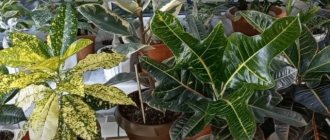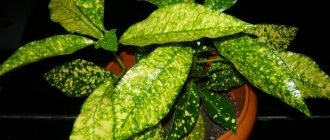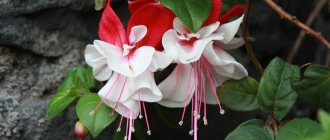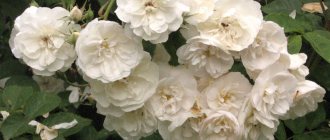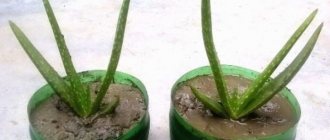Author: Elena N. https://floristics.info/ru/index.php?option=com_contact&view=contact&id=19 Category: Houseplants Published: January 03, 2019Last edits: January 11, 2021
- Growing from seeds
- Croton dropped its leaves
- Croton variegated (variegatum)
Croton (or codieus) is the most beautiful representative of indoor decorative foliage plants. Its dense glossy leaves amaze with the variety of shapes and colors in the autumn palette. The seeds of crotons growing in nature are used to obtain medicinal oil, and valuable resins are extracted from some species.
The cultivated croton is a terrible sissy, constantly demanding love and attention. But this elegant bush is so charming that you will readily forgive all its whims, especially since from our article you can find out:
- what conditions does croton need;
- what care will make the plant look as attractive as possible;
- how to protect croton from diseases, pests and other problems.
Planting and caring for croton
- Flowering: the plant is classified as an ornamental deciduous plant.
- Lighting: bright sunlight before noon, and then bright diffused light or light partial shade.
- Temperature: in summer 20-22 ˚C, in winter not lower than 16 ˚C.
- Watering: constant but moderate.
- Humidity: high. The plant needs constant spraying and washing of the leaves, as well as regular shower procedures (once or twice a month).
- Feeding: with a solution of complex mineral fertilizer for decorative deciduous plants twice a month from April to November, the rest of the time - once a month.
- Dormant period: winter.
- Transplantation: young plants - 2 times a year, adults - 1 time every two years.
- Reproduction: seeds, leaf and stem cuttings.
- Pests: mealybugs, scale insects, nematodes, spider mites.
- Diseases: sooty fungus, gray rot,
- Properties: the juice of the plant is poisonous.
Read more about growing croton below.
plant (lat. Croton) , also known as codiaeum (lat. Codiaeum) or “Joseph’s cloak ,” belongs to the genus of the Euphorbiaceae family. Nobody knows for sure what the name “croton” means, which gardeners liked more than the scientific “codiaum”, translated from Greek meaning “head”. Maybe this name comes from the name of a city in southern Italy, where Pythagoras once founded his school, or maybe in some dialect this word means “shrub”... The homeland of wild crotons are the islands of the Pacific Ocean and Northern Australia, India, as well as Southeast Asia.
The number of species in the genus varies from 17 to 1200, but in indoor culture croton flowers are represented only by variegated croton and its hybrids. The croton flower is one of the most beautiful decorative foliage indoor plants, which serves as an excellent interior decoration and, as a rule, does not take up too much space. In some countries, the croton houseplant is considered the guardian of the hearth, protecting the house from bad energy.
- Pansies
Description of the origin and appearance of the plant
The East is rich in bright colors. He gives us many beautiful plants that amaze with their beauty and claim the palm. But I want to give the victory to croton, it is in it that all the colors of the autumn forest are harmoniously combined, the riot of color fascinates and at the same time calms.
The East gives us bright plants, one of which is croton
Croton or codiaum belongs to the humble Euphorbiaceae family. Plants growing in the tropical forests of Southeast Asia, India, the Pacific and Malaysian islands are represented by numerous species. Among them there are trees, shrubs, and herbs. The shape and color of the leaves are varied. This diversity is due to the different climatic characteristics of the regions in which croton grows.
In their natural environment, crotons reach 3 and even 4 meters in height; the size of domestic species is half that. It does not grow quickly in the room, it takes a very long time to get used to the new place.
Croton naturally grows to a height of 3 meters
The leaves have a hard, leathery surface and are attached to short petioles. The shape of each variety is different. The leaf blade can be three-fingered, guitar-shaped, elliptical, ribbon-elongated, spiral-shaped and corrugated. The predominant colors are red, yellow, green, orange, pink and white. It is the leaves that are the undeniable decoration of croton. Their mass resembles bright autumn leaves collected in a bouquet.
Croton leaves resemble an autumn bouquet
Care must be taken when caring for Croton. The milky sap of the plant causes irritation to the skin and mucous membranes.
Croton flowering can be called inexpressive. White small flowers are collected in racemes and look very poor against the background of luxurious foliage. It blooms extremely rarely in indoor conditions. And if this happens, then it is best to remove the inflorescences. Peduncles will take away excess strength from the plant and slow down its growth.
Flowering croton, against the backdrop of bright foliage, looks inexpressive
The name croton was assigned to the plant in 1762 thanks to the work of Carl Linnaeus. Although now it is more correct to call it codeium, this is what the Dutch naturalist Rumphis called the flower in 1690, when he first wrote up its description.
Croton cannot be called too capricious a plant. But you will find mutual understanding if you can provide the plant with the necessary conditions for normal growth. Evergreen crotons decorate residential and office spaces. The flower can harmoniously fit into any interior.
Type of croton and its varieties grown indoors
Despite the huge variety of species, only one type of croton is grown in indoor floriculture - variegated or variegatum. It and its varieties are successfully used in indoor floriculture.
| Varieties | Description |
| Croton variegatum | It is on its basis that many hybrid forms have been developed. It has an erect, branching stem, bare below, up to 3 m high (in room conditions only 70 cm). The leaves are leathery, large - 30 cm long. A characteristic feature of the species is its color scheme, in which yellow-green color predominates, as well as the varied shape of the leaves. The color of the leaf blade changes depending on lighting and other external stimuli. Flowers are dioecious. |
| Croton Petra | One of the most popular varieties. The trunk is branched, with alternately arranged leaves. The leaf blades are pointed-lobed or oval, dense, glossy. The main background is dark or light green. The veins and edge of the leaf are painted in a rich yellow color. |
| Croton Mrs. Eyeston | Tree form. The leaves are elongated and wide, with rounded tips. They are brightly colored - yellow, red, pink and golden shades predominate. |
| Croton Excellent | A small bush with oak-shaped leaves. The top of the leaf is green-yellow, the underside has a burgundy-red tint. |
| Croton the Black Prince | The plant is rare. Has an exotic appearance. The leaves are black-green in color, with bright spots of orange or red veins and spots. |
| Croton Disraeli | Bush-like form. The leaves are lobed and green with yellow veins. The underside of the sheet is brick-brown in color. |
| Croton Zanzibar | It is distinguished by a narrow, long leaf shape. The color is dominated by yellow, red and green colors. Falling leaves look impressive in hanging flowerpots or on a standard form. |
| Croton Mammy | Unusual curly foliage and variegated leaf color are the main distinguishing features of the hybrid. The leaf blade is long, twisting around its axis. |
| Croton Tamara | The plant can grow more than a meter tall. The leaves are hard and leathery. Their shape is elongated oval with an uneven edge. The coloring is very unusual - the predominant color combination is white and green, sometimes there may be splashes of pink, purple or yellow. |
Photo gallery: color variety of croton
Croton variegatum Croton Petra
Croton Mrs. Eyeston
Croton Excellent
Croton Black Prince Croton Disraeli
Croton Zanzibar
Croton Mammy
Croton Tamara
Very often in flower shops you can read “Croton Mix” on the price tag. In fact, this is not a name, there is no such variety as “Mix”. It’s just that suppliers often place several hybrids on one pallet and combine them under one name.
This is what a Mix of Croton varieties looks like
Features of cultivation
The indoor croton flower is a bush with leathery leaves of various shapes: asymmetrical, oblong-lanceolate, pointed or blunt-pointed, entire-edged, three-lobed, notched, broadly ovate, etc. Young leaves, usually lighter shades of yellow-green, become richer green and burgundy colors over time, so your indoor croton flower is colored like an elegant autumn forest. A common feature for leaves of all varieties and varieties is pronounced venation. The flowering of croton will not cause you any delight, since it is a pendulous axillary racemose inflorescence of inconspicuous cream flowers.
In the photo: Croton growing outdoors
The home flower croton has earned the reputation of one of the most capricious plants. What are the features of caring for croton?
- Croton juice is poisonous. It causes diarrhea, vomiting, and contact dermatitis, so all work with croton should be done with gloves.
- Croton at home requires not only spraying the leaves with a spray bottle, but also wiping them with a damp sponge. In the summer, give your croton a warm shower every month.
- Croton does not tolerate watering with cold water and drafts!
- Sometimes at the beginning of the growing season, croton leaves take on strange shapes. No one knows how this is explained, but croton has a high degree of mutation, which is why it has become possible to develop many varieties and hybrid forms of this plant, and they differ only in how the leaf of one or another variety of croton looks.
- The inconspicuous flowering of croton takes a lot of energy from the plant, and if you are not going to engage in breeding experiments, it is better to remove flower buds or peduncles immediately.
Kinds
The genus Codiaeum includes more than a thousand different plants, and it includes not only shrubs, but also trees. However, only one variety of croton is used as an indoor flower - Codiaeum variegatum, or variegated Codiaeum. In turn, within this species there are a huge number of different varieties and hybrids, including those bred through selection. They differ from each other in shape, size and color of leaves.
Read more about the types of croton.
So, in flower shops today you can buy the following varieties of croton:
- narrow-leaved (Angustifolium): leaves have a pointed shape, do not exceed 15 mm in width, color - golden spots on a green background;
- adnexal (Appendiculatum): the leaves are oval, but in the middle part they have a narrowing, as if they are tied with a belt;
- curly (Crispum): leaves are narrow and wavy, very brightly colored;
- Mrs Eyeston (Mrs. Iceton): the leaves are wide with curled tips, painted with pink and burgundy spots, in young plants there are blotches of cream color. Can be shaped like a neat tree;
- Zanzibar (Zanzibar): narrowed, decoratively curved and very dense leaves, painted with purple, yellow and orange stripes on a green background;
- Excellent (Excellent): the leaves are shaped like oak leaves, the color is an interlacing of spots and stripes of green and yellow shades, in the lower part they can be burgundy;
- Petra (Petra): Leaves are oval, pointed or lobed, yellow on the edges and yellow mottled in the center. The plant itself branches well;
- Disraeli (Disraeli): leaves are lanceolate, two-colored - green at the bottom, burgundy at the top;
- Splashes of champagne (Splashes of champagne): leaves are narrow, green in color with small yellow spots;
- Mammy (Mammi): distinguished by a wide variety of both the shape of the leaf blade (elongated, twisted, wavy) and its color;
- Tamara (Tamara): light edging in the form of spots on medium-sized leaves;
- Nervia (Nerve): jagged edges on long leaves with bright, multi-colored colors;
- Gold san (Gold sun): the leaves are oblong, narrow at the base, the plant itself is quite large and spreading;
- dragon (draco): an American variety of croton, the main value of which is a very valuable red resin, widely used in medicine and the chemical industry;
- thorny (echinocarpus): a variety very similar to dragon fruit, distinguished by the presence of thorns on the fruit capsule;
- Cascarrolla (Eluteria): another variety of medicinal croton, it is also one of the few varieties whose flowers look very decorative and, in addition, have a magnificent aroma (the word “cascarrolla” is translated as “bark”, the variety received this name due to the fact that it is its bark that has numerous medicinal properties);
- laxative (tiglium): green leaf blade, valued for the oil contained in the seeds and which has a pronounced laxative effect;
- Norm (Norma): the leaves are large, at first yellow-green, as they form - red-green;
- Baron Jay de Rothschild (Baron J. De Rothschild): distinguished by its brightness and variety of colors, which can include orange, pink, yellow and green in different shades;
- Golden Star (Gold Star): leaves are long and narrow, united into star-shaped rosettes, green in color with yellow mottling;
- apple leaf (Appleleaf): distinguished by red edging on the foliage;
- Gold Moon : leaves are decorated with yellow stripes.
Croton care at home
Rules of care
Croton loves bright light, but can only take baths in direct sunlight in the morning or before sunset, so in the summer, a northern window sill is suitable for it, and in winter, when the sun shines but does not warm, a southern one is suitable. If you have the opportunity to take your croton out into the fresh air and bright, indirect light in the summer, do not neglect it. The most comfortable temperature for croton in summer is 20-22 ºC, in winter – not lower than 16 ºC.
In the photo: Handsome Croton
Croton needs watering so that the earthen ball is slightly moist all the time, but at the same time, so that the moisture does not stagnate in the roots and does not cause the risk of their rotting. Water for irrigation should not be cold, and most importantly, it must be filtered or at least settled. Air humidity is of great importance for croton, so you will have to regularly spray or wipe the leaves with a damp washcloth, and in the summer, give it a warm shower once a month, but so that water does not flow into the pot.
How not to ruin zamioculcas - advice from experienced gardeners
Croton is fertilized with a solution of complex mineral fertilizers on pre-moistened soil from April to November twice a month; in winter, once a month is enough. To form a beautiful crown in croton, pruning (for an adult plant) and pinching (for young crotons) is used. Plants that have reached 15 cm in height are pinched, and then each time the shoots grow 20 cm. In adult plants, after pruning, the sections are treated with sulfur or charcoal powder.
- How to care for gerberas (video)
It is advisable to remove the emerging flower buds or young flower stalks, because flowering, which has no decorative value, exhausts the croton, and this affects the health and beauty of its leaves.
In the photo: Growing croton in a pot
Transfer
Young crotons are replanted twice a year, mature ones - once every two years, and each subsequent pot should be 2 cm in diameter larger than the previous one. When your croton occupies a container with a diameter of 25 cm, this will be its last replanting, but after that you will have to annually remove the top layer of soil from the pot and replace it with fresh substrate. The soil for croton should be approximately the following composition: turf, peat, leaf soil and river sand in equal parts.
When replanting, it is advisable not to disturb the croton earthen ball, but simply transfer it from the old pot into a new container with a drainage layer of about a quarter of the pot’s volume.
Croton in winter
When the cold season comes, the croton is moved from the northern window sill to the southern one, watering is reduced, but they continue to adhere to the same principle: the earthen ball should be slightly moist. Water procedures are also continued - spraying and wiping the leaves with a damp sponge, but this is not done as often as in the warm season, and it is better to forget about the shower until the summer. The plant needs to be fed no more than once a month, but some professionals are confident that in winter croton does not need feeding at all.
In the photo: Yellow croton leaves
Narrow-leaved varieties of croton
A very spectacular croton, varieties of which are used in the design of not only city apartments, but also spacious country houses and offices. By providing the plant with favorable conditions, you can get a bush more than 1 m high. The variety differs from other crotons in its unique narrow leaves.
Needs diffused light, moderate watering, spraying. In the shade it can shed its leaves, exposing the trunk. In winter, it is not recommended to place croton near heating appliances. Dry air is harmful to it. At temperatures below +18 °C, a houseplant may die.
Croton Mammy
A very bright and unusual variety. Thanks to its colorful foliage, it will never get lost among other indoor plants. The main features of croton:
- bush height more than 1 m;
- leaf blades are narrow, small, wavy or spirally twisted around a central vein;
- variegated color - a combination of dark green, red, yellow, pink shades.
To preserve its decorative appearance, it is recommended to provide the plant with good lighting, while shading it from direct sunlight. Mammy loves moist soil and regular spraying.
Croton Sunny Star
A distinctive feature of the plant is its many side shoots. Due to its tendency to grow all-round, the indoor flower forms a luxurious bush, filling the entire space in the pot. Main features of the variety:
- bush height 0.6-0.8 m;
- the leaf blade is dense, leathery, elongated, rounded at the tips;
- The color depends on the location, as well as the age of the leaves.
Old foliage is dark green with red spots and streaks. The middle one is a combination of rich greens and yellow. Young leaves are light green with splashes of lemon tint. To prevent Sunny Star from losing its decorative effect, it is recommended to place it on western or eastern windows. This way he will receive his dose of sunlight and will not burn.
We recommend: New varieties of phlox.
Croton Zanzibar
A popular variety among gardeners. It looks harmonious both in a small city apartment and in a spacious office space. The main features of a houseplant:
- codiaum height is about 1 m;
- the leaf blade is leathery, dense, narrow, lanceolate, with curves;
- The color is represented by a combination of all shades of green, purple, yellow, and red.
Crotons Zanzibar are one of the easiest and most unpretentious to care for. They should not be placed in the shade or allowed to dry out too much. Otherwise, the plants will shed their leaves, exposing the trunk, losing all decorativeness. They respond well to a warm shower. It is best to spray with boiled water to avoid the appearance of unsightly lime stains on the leaves.
Croton Tamara
One of the most unusual and rare varieties in floriculture. Forms one straight stem with many leaves raised upward. The sizes are average, depending on growing conditions. The main features of a houseplant:
- bush height up to 1 m;
- the leaf blade is dense, leathery, elongated, with a pointed tip, jagged edges;
- the stem and petioles are dark green.
The highlight of croton is its feathery leaves. Most of them are white with a scattering of green dots. But there are also leaves with more voluminous green spots. Like all representatives of the species, Tamara needs diffused light and regular spraying. It is necessary to water as the earthen clod dries. The flower does not tolerate stagnant water.
Croton propagation
Growing from seeds
At home, croton is propagated by seeds, when it comes to growing hybrids, and by stem or leaf cuttings. Croton seeds quickly lose their viability, so you need to sow freshly harvested seeds. It should also be taken into account that the germination process takes a lot of time, and most importantly, that varietal characteristics are usually not preserved during generative propagation. Before planting, large croton seeds should be heated for half an hour in water at a temperature of 60 ºC and left for a day to swell. Sowing is carried out at a depth of one centimeter, the temperature required for seed germination is 22 ºC. Until the seedlings appear, the soil in the container with the seeds is moistened with bottom watering. When the seedlings have their third leaf, they are planted in separate pots with a diameter of 7 cm and cared for like an adult croton.
In the photo: Growing croton
Vegetative method of propagation
How to propagate croton by cuttings? The easiest way to root is an apical cutting 6-10 cm long, but if you need several cuttings, then the shoot is cut into pieces so that each segment has at least one internode with one healthy leaf. Lignified or semi-lignified cuttings take root most easily.
The poisonous milky sap that flows from the sections should be washed off with water, and then the sections should be allowed to air dry for three hours.
- Dracaena or Cordyline?
On the upper part of the apical cutting, the leaves are shortened parallel to the veins by half, and the leaves are removed from the lower part. Then the cuttings are placed, dried and root-treated, into a container with water heated to 23-30 ºC (to avoid rotting of the planting material), and placed under bright, diffused light to grow roots. When the cutting grows roots 2 cm long, it is transplanted into a croton substrate. In the first decade after transplantation, it is necessary to create increased air humidity around the cuttings transplanted into the ground through frequent spraying. You will know that the cuttings have begun to grow when the elasticity of the leaf is restored.
Reproduction
The croton plant can be propagated by seeds, sowing them in compliance with certain rules. A faster way is to take cuttings. Croton transplantation is an operation during which pruning can be done and the cut shoots are suitable for rooting.
Seeds
Codiaum is a plant that produces seeds after flowering. You have already seen how exotic flowers bloom, but this is what the seeds obtained after ripening look like.
Croton seeds and flowers
They are suitable for reproduction, but must first be prepared:
- the seeds are soaked in hot water (not boiling water) for 2-3 hours, then the liquid is drained and the planting material is left for a day so that the shell swells;
- sown in a loose substrate to a depth of 10 cm;
- Place in a warm place and cover with film or glass.
With regular soil moisture and ventilation, the first shoots will appear in a month. After the formation of 2-3 leaves, they are dropped into separate cups. It is best to carry out propagation at home in February-March.
Cuttings
Crotons can also be propagated by cuttings. The branches remaining after trimming the bush are selected, the cut is washed in water to remove the milky juice, and dried with crushed charcoal. In order for the plant to take root, it is soaked in the Kornevin solution. As soon as the roots reach a length of 1.5-2 cm, the cuttings can be planted in narrow containers and grown in a warm, well-lit place. After some time, the crown of the mature plant is pinched, so it will branch better and within a year you will have a new exotic bush with beautifully colored leaves.
You can see what other poisonous plants there are here.
Pests and diseases
Croton is affected by mealybugs, nematodes, scale insects and spider mites, and most often by mites. It is difficult to say why croton attracts them so much, but sometimes fighting with them brings the owner of the flower to an extreme degree of irritation, and he, despairing of winning this fight, simply throws out the croton. But let me remind you: if you follow all the rules of care, your plants are not afraid of either insects or diseases, and the appearance of mites is explained by the fact that the croton was rarely washed and watered irregularly, so you only have yourself to blame for this kind of trouble.
You can fight spider mites, scale insects and scale insects by wiping the ground parts of the croton with a tobacco solution with added soap, which must be washed off after an hour and a half so that it does not get into the substrate.
In the photo: Healthy croton
Croton dropped its leaves
If the plant has dropped its leaves, it means it cannot drink. This happens if the roots are cold. Move the plant to a warm, bright place, adjust the moisture regime, allowing the earthen clod to dry a few centimeters deep between waterings, stop feeding the flower, spray the leaves well and put a transparent bag or cap on the plant.
All about azaleas in questions and answers
Why does croton dry out?
If only the lower leaves of a croton dry, then there is no need to worry: the gradual exposure of the lower part of the stem is a natural process for crotons. Dry tips of the leaves indicate that the plant suffers from low air humidity, and for croton a comfortable humidity level of 70% is comfortable. If the edges of the leaves dry out and brown spots appear on them, it means that the room is not warm enough and the croton is freezing.
If the croton's leaves not only dry out, but also fall off, then its roots definitely do not have enough moisture.
In the photo: A rare variety of croton
Why does it drop leaves?
Often readers of the site ask the question why croton leaves fall. We have already mentioned the first two reasons - chronically insufficient watering and low air humidity. This also happens when the room temperature is too low, as well as from temperature fluctuations or drafts.
What to do if croton leaves fall off?
- First, carefully re-read the rules for caring for croton.
- Secondly, analyze where and in what ways you violated these rules.
- Thirdly, correct your mistakes and prevent them from happening again.
Types and varieties
In indoor culture, variegated croton is grown, the distinctive feature of which is the ability to change the color and shape of the leaves depending on living conditions. It was this quality that made the species the basis for experiments in selection, which culminated in the development of many varieties, hybrid forms and varieties.
In the photo: Croton variegated (variegatum)
Croton variegated (variegatum)
grows in nature in Pakistan and China, sometimes reaching three meters in height. The leaves are short-petioled. The color of the leaves is green and brown. This species has several forms, differing in the shape of the leaves: adventitious, lobed, flat-leaved and decorated, which served as the basis for the development of many remarkable varieties.
Varieties:
- Mrs. Eyeston - grows as a large tree or bush with leaves brightly colored dark burgundy with bright pink spots, although there is a variety with golden leaves with almost black fragments and a variety in yellow-pink tones;
- Petra - in nature it grows to a height of up to four meters, branches well, the shape of the leaves is oval, lobed or pointed, the color is dark green with a bright yellow edging and contrasting veins and specks of the same color;
- Black Prince - its wide oval flat leaves of black-green color with many yellow, red and orange spots look very exotic;
- Disraeli has lobed leaves, colored green at the top with yellow veins and specks, and brick-brown at the bottom;
- Excellent is distinguished primarily by the shape of the leaves, reminiscent of oak leaves; the color of the lower part of the leaf is red-burgundy, and the upper part is yellow-green.
The following varieties of variegated croton are also of interest: mollucian, minus, genuine, oval-leaved, tortoiseshell, curly and spiral. But no matter what type you purchase, you can believe that it will become the most noticeable decoration in your interior.
Description of Croton
In the wild, croton grows up to 3 meters in height. And at home, this indoor plant grows up to 1 meter, and almost all of its species, with the most careful care, do not grow above one and a half meters. This flower is very beautiful and decorative. It can decorate not only our home, but also the lobbies of hotels, schools, medical institutions and various offices. Its leaves, of unusual color and shape, always attract people's attention. Croton has the shape of a small tree, although one should not hope for the rapid formation of a beautiful crown. In order for a flower to grow neat and beautiful, it must be trimmed, thereby forming a lush bush.
This is how croton blooms
Codiaum is a flowering plant. When croton rarely blooms, an arrow appears with small, inconspicuous flowers of light yellow color. These flowers are not particularly beautiful or decorative, but croton spends considerable energy and nutrients on their flowering. Therefore, flower growers usually remove these arrows immediately.
Croton species
Codiaum variegated is the most common domesticated species of codiaum. It is this plant that gardeners often call croton. There are about 15 species of croton, from which many hybrids have been developed. Different varieties differ in size, color and shape of leaves. Below is a description and photo of the most popular of them.
Petra
Croton Petra has bright green, dense, glossy leaves that are arranged alternately on the stem. They come in oval or lobed shapes. The edges of the leaves and veins are bright yellow. The trunk is branching.
Mrs Eyeston
Croton Mrs. Iceton has broad, short leaves with a rounded tip. The color of the leaves is uneven, has different shades - yellow, red, pink.
Norm
Croton Norma is distinguished by the fact that on its emerald green leaves yellow spots of different sizes and bright red veins clearly stand out.
Goldfinger
Gold Finger variety has very long, thin, green-yellow leaves.
Excellent
Excelent has leaves like oak - large, dense, with veins of different colors. The upper side of the leaf is yellow-green, and the lower side is yellow-purple down to the petiole.
Mammy
Mammy variety has beautiful red-green leaves interspersed with yellow, red and pink. The leaves are wavy, arching, and curl inward.
Gold Sun
Variety Gold Sun - has large oval leaves of light green color with yellow spots of different sizes.
This may be interesting: Monstera - caring for a beauty with a scary name
Croton Zanzibar is also distinguished by its leaves - thin, long, hanging down, and different colors - from yellow-brown and orange to red.


